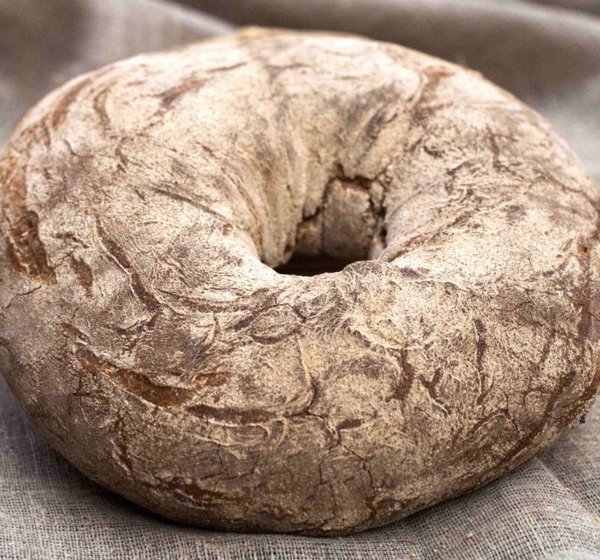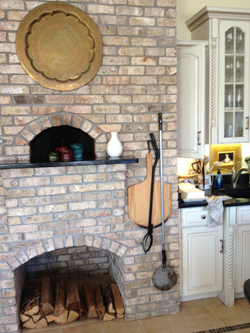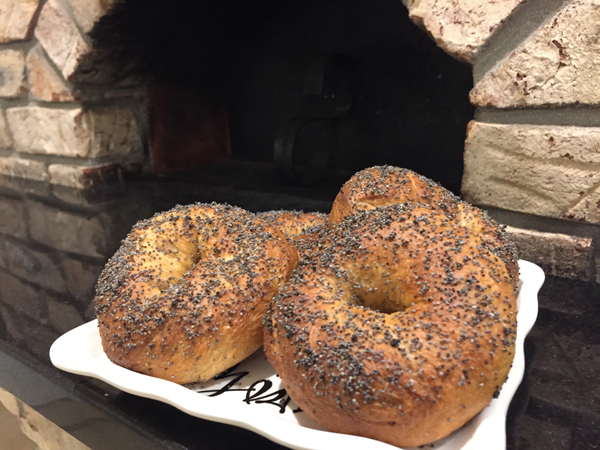The topic of home-made bagels came up recently in a discussion with my nephew who called my attention to an excellent blog site (realdealcooking.com) that elaborates on the proper technique for making this style of bread product. My interest having been sufficiently piqued I soon embarked on the inevitable research tedium that partly characterizes my life in the kitchen. (The rest is characterized by inertia punctuated by rare fits of perceived talent).
My intention was to try to find a connection between bagels and Italian cuisine, because I slavishly believe all good things to eat in the world originated in Italy.
In the case of bagels I learned that following conventional research pathways leads one to the conclusion that bagel bread is strictly an Eastern European and Jewish phenomenon with history dating back only as far back as the 15th or 16th century primarily in Poland.
However since we are dealing with a variation of bread, the staff of life, a food dating back thousands of years with origins in ancient Egypt and elsewhere along the Fertile Crescent bordering the Mediterranean Sea, I became suspicious. So I dug deeper.
 As I suspected bagels are not originally from Eastern Europe. They are in fact direct descendants of a small thick circular bread bun with a hole in the center developed by a popular Roman general. His name – Quintus Julius Bagellius, shown here. He appears in the archives of the Roman Empire preserved and housed in the dusty basement of Rome’s city hall on the Capitoline Hill.
As I suspected bagels are not originally from Eastern Europe. They are in fact direct descendants of a small thick circular bread bun with a hole in the center developed by a popular Roman general. His name – Quintus Julius Bagellius, shown here. He appears in the archives of the Roman Empire preserved and housed in the dusty basement of Rome’s city hall on the Capitoline Hill.
The recipe itself is described in a publication that is universally recognized as the world’s first cookbook, attributed to the popular Roman gourmand of the time – Apicius.
The hole in the center of the small loaf was Bagellius’ innovation that allowed the convenient transportation of bread – on a stick- from battlefield to battlefield as the Roman Empire expanded. The bun itself was small enough so that the soldiers could munch on it while hacking away at the Barbarians from across the Rhine.
Consequently it is now happily established in my mind that bagels are not Eastern European, not Polish and definitely not unique to the Jewish community in any sense. They are a native of the Italian peninsula and that’s where the story begins. The word ‘bagel’ itself, as is quite obvious, is a shorthand reference to General Bagellius.
All seriousness aside I now cite a far more more authoritative reference:
It is the book written by Maria Balinska entitled “The Bagel: The Surprising History of a Modest Bread” (Yale University Press, 2008) which traces the bagel to its origins in southern Italy. The bread she describes had a circular form with hole in the center, boiled and baked in an oven. Here is a photo downloaded from an Italian website.

So I rest my case. Let’s move on.
Over the years, following various migrations from Italy to elsewhere in Europe, apparently two strains of bagel production emerged amongst the Eastern European population, Jewish and Gentile alike. Skipping the details, over time by virtue of immigration one eventually became anchored in New York City and the second became located in – strangely enough – Montreal Canada. Why Montreal, and not, say, Peoria Illinois, will provide an excuse for future research.
Bagels from the two popular claimants of originality are not the same, as you would expect. Both however are now exclusively associated with the Jewish tradition. So the question is, which one is truly representative of what is considered to be the authentic bagel? And more importantly, which one most closely reflects the innovation launched by the ancient Italians, i.e the signature “donut hole”?
I believe the answer is Montreal, not New York.
My belief that this version is – more or less – the most representative of the old traditions is based, among other things, on the fact that they are baked in a wood burning oven, which is all that existed for cooking in the olden times. Consequently the recipe below is based on the Montreal version as published, ironically, by New York Times food writer Marcy Goldman. See cooking.nytimes.com/recipes/6795-montreal-bagels.
I say “more or less” for two reasons: first, the ancients did not have finely ground King Arthur bread flour handy in the kitchen, and second, they did not have anything resembling Fleischman’s Rapid Rise yeast. Instead they used just ordinary farmer’s flour and water and allowed ambient yeast to do the work. Or, more likely they used a preserved yeast culture similar to the age old French bread starter called levain.
 As for the wood-burning oven, if you’ve ever been to my place you already know I have one of those inside my kitchen. Photo attached. The big problem with this cooking appliance is maintaining uniformity of temperature. The commercial brick ovens start up in the morning, run all day and can maintain constant temperature without having to add fuel every 20 or 30 minutes. I have to work around that and the effort is not always successful.
As for the wood-burning oven, if you’ve ever been to my place you already know I have one of those inside my kitchen. Photo attached. The big problem with this cooking appliance is maintaining uniformity of temperature. The commercial brick ovens start up in the morning, run all day and can maintain constant temperature without having to add fuel every 20 or 30 minutes. I have to work around that and the effort is not always successful.
In any event the recipe is below. I should note that it does not follow the New York Times faithfully for reasons noted.
The Authentic Bagel from Montreal (by way of Italy)
Ingredients for 16-18 bagels
- 1 ½ cups warm water (NYT says “room temperature” which is ok if you’re willing to wait all day for the yeast to activate)
- 2 packages dry yeast or 1 1/2 ounces fresh yeast (I use the standard dry yeast, not Rapid Rise).
- 1 teaspoon sugar (hard to believe the 16th century Polish peasants had a sugar bowl in the kitchen but maybe they did)
- 2 ½ teaspoons salt (some experts claim that the true Montreal bagel has no salt)
- 1 whole egg plus 1 egg yolk
- ¼ cup oil or rendered lard or Crisco (I’m betting big money that the original fat additive was lard, not oil)
- ½ cup barley malt (The NYT says honey, I suppose either one)
- 4 cups or more flour plus 1 cup whole wheat (all purpose bread flour is the New York Times’ choice but I think regular unbleached AP with a dose of rye or whole wheat would best mimic the original. Only the aristocracy could afford high-gluten white flour in the old days)
- 3 quarts water for boiling (water in the 16th century did not contain fluorine, just H2O, so I use bottled spring water)
- ⅓ cup barley malt to be added to the water
- Sesame or poppy seeds for sprinkling on top (doubtful the ancients used either one but plain undressed bagels are so dull!)
Preparation
- In a large mixing bowl or in the bowl of an electric mixer with a dough hook, blend together the water, yeast, sugar and salt. Stir in the whole egg, the yolk, oil and 1/2 cup barley malt and mix well.
- Add the 5 cups flour and mix until the dough becomes stiff . Transfer to a floured work surface and knead to form a dense but supple dough. (Some writers say the dough should be stiff as Play Doh, but I don’t care for the “jawbreaker” bagel).
- Add more flour as needed to achieve a stiffness you think you might like.
- When the dough is smooth and elastic place it in a lightly oiled bowl and cover with a sheet of plastic wrap.
- Let the dough rest about 2 hours, or overnight in the refrigerator. (The NYT says 20 minutes but that is strictly for short cutters). Punch it down and after kneading for 5 minutes or so divide into 16 or 18 equal portions, shaping them into little snowballs. (I use a kitchen scale to form 16 or so portions that are exactly 3 ounces in weight). Basically I follow my pizza-making instincts which call for pressing down on the dough portions, folding them over several times and then pinching the folds together to make a round shape.
- As for the water for boiling, NYT says pour the water into a Dutch oven (that’s if you want to make Dutch bagels, otherwise any large pot will do), along with the additional 1/3 cup malt syrup, and heat to boiling. Cover, reduce the heat, and allow to simmer while preparing the bagels.
- Shape the rounded dough portions into bagels or doughnut-like rings by sticking your finger in the middle, forming a hole, and then enlarge it enough to be able to roll the circle into spirals using your fingers moving in opposite directions. (This is also tricky. Otherwise you can roll the dough into a log and then with palms moving in opposite direction, create a spiraled shape. Bring the two ends together and press to close the circle. This of course results in a bagel with an unwelcome joint seam). You can of course skip this bit of sophistication.
- Let the bagels rest 15 minutes on a towel-lined baking sheet. Preheat your wood-burning oven to 500 degrees. Bring the water back to a boil and remove the lid. Have a supply of poppy seeds or sesame seeds nearby. When the water is boiling use a slotted spoon or spatula to add three or four bagels to the water. As they rise to the surface turn them over and let them boil an additional minute before removing them. Then place them on a baking sheet and sprinkle them with the seeds or toppings of choice.
- Continue boiling the remaining bagels in batches of three until all have been boiled and seeded. Bake until they are medium brown, approximately 10 minutes (NYT says 20 minutes, which is ok if you like hockey pucks), rotating constantly to prevent burning or uneven cooking. (If you’re using a convection electric or gas oven no need to rotate. Actually in the wood oven mine achieved complete cooking in much less than 10 minutes). Remove from the oven. Once cooled the bagels can be placed in a plastic bag, sealed and frozen.

Note: In tribute to the original Roman/Italian bagel ancestor next time I will dust my bagels with Parmesan cheese. No poppy seeds, no sesame seeds, no caramelized onions.
